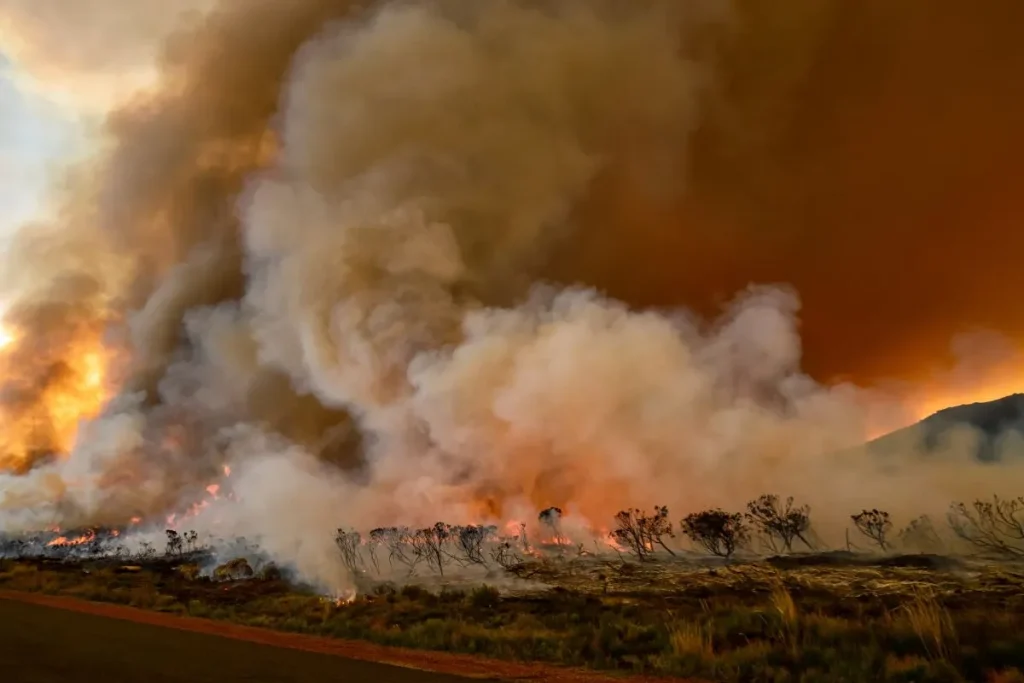Wildfires are a formidable natural force, capable of devastating vast landscapes and affecting countless lives. Yet, amidst the destruction, there exists a unique and haunting beauty: the phenomenon of a wildfire sunrise. The interplay of smoke, light, and atmosphere during a wildfire sunrise can create stunning visual spectacles. This article explores the dual nature of wildfire sunrises, capturing both their aesthetic allure and the profound environmental and health impacts of the smoke they entail.
The Aesthetic Beauty of Wildfire Sunrises
1. The Science Behind the Colors: Wildfire smoke contains a mix of gases and fine particulate matter that scatter sunlight in distinctive ways. During sunrise, the low angle of the sun causes its light to pass through a thicker layer of the Earth’s atmosphere, including the smoke from wildfires. This scattering process filters out shorter wavelengths of light (blues and greens), allowing longer wavelengths (reds, oranges, and pinks) to dominate. The result is a sunrise with intensified and sometimes surreal colors.
2. Artistic Impressions: Photographers and artists are often drawn to the dramatic visuals of wildfire sunrises. The contrast between the fiery hues of the sky and the dark silhouettes of the landscape can create striking compositions. Many find a paradoxical beauty in these scenes, where the calmness of the morning light contrasts sharply with the knowledge of the fire’s destructive power.
3. Personal Reflections: For those witnessing a wildfire sunrise, the experience can be profoundly moving. The unusual light and colors can evoke a sense of awe and contemplation. However, this beauty is tinged with the awareness of the ongoing destruction and the potential threat to lives and homes.
The Impact of Smoke

1. Environmental Consequences: While wildfire sunrises may be visually stunning, the smoke that creates these effects has significant environmental impacts. Smoke from wildfires contributes to air pollution, releasing large amounts of carbon dioxide, carbon monoxide, and fine particulate matter (PM2.5) into the atmosphere. These pollutants can affect air quality over vast areas, far beyond the immediate vicinity of the fire.
2. Health Risks: The fine particulate matter in wildfire smoke poses serious health risks. These tiny particles can penetrate deep into the lungs and even enter the bloodstream, exacerbating respiratory conditions such as asthma and bronchitis, and increasing the risk of heart attacks and strokes. Vulnerable populations, including children, the elderly, and those with preexisting health conditions, are particularly at risk.
3. Long-Term Climate Effects: Wildfires and the resulting smoke have broader implications for the climate. The carbon dioxide released by wildfires contributes to the greenhouse effect, while the black carbon (soot) in smoke can settle on ice and snow, reducing their reflectivity and accelerating melting. This can create a feedback loop, where warming temperatures increase the likelihood and severity of wildfires.
4. Ecological Impact: Wildfires can have both destructive and regenerative effects on ecosystems. While intense fires can devastate habitats and wildlife populations, they can also play a role in maintaining the health of certain ecosystems. For example, some plant species have adapted to fire and rely on it for seed dispersal or to clear out competing vegetation. However, the increasing frequency and intensity of wildfires due to climate change can disrupt these natural processes and lead to long-term ecological imbalances.
Coping and Adapting
1. Preparedness and Response: Communities in wildfire-prone areas are increasingly focusing on preparedness and resilience. This includes measures such as creating defensible space around properties, using fire-resistant building materials, and developing evacuation plans. Public education campaigns also aim to raise awareness about the health risks of wildfire smoke and promote actions to reduce exposure.
2. Technological Advances: Advances in technology are aiding in both the prediction and management of wildfires. Satellite imagery and computer modeling can help predict fire behavior and assess the potential spread of smoke. Innovations in firefighting techniques, such as the use of drones for aerial surveillance and the development of fire-retardant materials, are also enhancing the ability to combat wildfires effectively.
3. Policy and Planning: Effective wildfire management requires coordinated efforts at local, national, and international levels. Policies aimed at reducing greenhouse gas emissions, managing forest health, and investing in firefighting resources are crucial. Land use planning that considers wildfire risks can help minimize the exposure of communities to fire hazards.
Conclusion
The phenomenon of a wildfire sunrise encapsulates the complex relationship between beauty and destruction. While the vivid colors created by wildfire smoke can inspire awe and artistic expression, they also serve as a reminder of the significant environmental and health impacts of wildfires. Understanding and addressing these impacts is essential for building resilience in the face of increasing wildfire activity. As we marvel at the striking visuals of a wildfire sunrise, we must also commit to actions that mitigate the risks and protect both human health and the natural world.
Get more info: https://www.timelinetale.com/